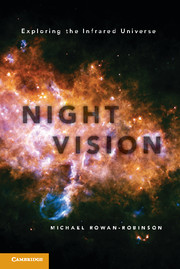Book contents
- Frontmatter
- Contents
- Preface
- 1 Introduction
- 2 William Herschel Opens Up the Invisible Universe
- 3 1800–1950
- 4 Dying Stars Shrouded in Dust and Stars Being Born
- 5 Birth of Submillimetre Astronomy
- 6 The Cosmic Microwave Background, Echo of the Big Bang
- 7 The Infrared Astronomical Satellite and the Opening Up of Extragalactic Infrared Astronomy
- 8 The Cosmic Background Explorer and the Ripples, the Wilkinson Microwave Anisotropy Probe and Dark Energy
- 9 Giant Ground-Based Near-Infrared and Submillimetre Telescopes
- 10 The Infrared Space Observatory and the Spitzer Space Telescope
- 11 Our Solar System’s Dusty Debris Disk and the Search for Exoplanets
- 12 The Future
- Epilogue
- Notes
- Credits for Illustrations
- Glossary
- Further Reading
- Bibliography
- Name Index
- Subject Index
8 - The Cosmic Background Explorer and the Ripples, the Wilkinson Microwave Anisotropy Probe and Dark Energy
Published online by Cambridge University Press: 05 March 2013
- Frontmatter
- Contents
- Preface
- 1 Introduction
- 2 William Herschel Opens Up the Invisible Universe
- 3 1800–1950
- 4 Dying Stars Shrouded in Dust and Stars Being Born
- 5 Birth of Submillimetre Astronomy
- 6 The Cosmic Microwave Background, Echo of the Big Bang
- 7 The Infrared Astronomical Satellite and the Opening Up of Extragalactic Infrared Astronomy
- 8 The Cosmic Background Explorer and the Ripples, the Wilkinson Microwave Anisotropy Probe and Dark Energy
- 9 Giant Ground-Based Near-Infrared and Submillimetre Telescopes
- 10 The Infrared Space Observatory and the Spitzer Space Telescope
- 11 Our Solar System’s Dusty Debris Disk and the Search for Exoplanets
- 12 The Future
- Epilogue
- Notes
- Credits for Illustrations
- Glossary
- Further Reading
- Bibliography
- Name Index
- Subject Index
Summary
The IRAS surveys had demonstrated the origin of the dipole anisotropy in the cosmic microwave background (CMB) and seemed to have shown that the mean density of the universe could be close to the critical value. They had also shown that there was more structure on large scales than expected in the standard ‘cold dark matter’ model for the universe. In this chapter, I describe how the Cosmic Background Explorer (COBE) mission, launched in November 1989, measured the spectrum of the background radiation with unbelievable accuracy and then went on to detect the expected small fluctuations in the background that would be the precursors of galaxies and clusters of galaxies today. However, these fluctuations turned out to be stronger than expected, confirming the IRAS conclusion that an additional ingredient was needed to explain this structure. The choice seemed to be between massive neutrinos or a cosmological constant. This and many other conundrums about the universe were settled by the WMAP mission, launched in 2001. The beautiful detail of WMAP’s measurements of CMB fluctuations on both small and large angular scales heralded a new era of precision cosmology.
The Cosmic Background Explorer and the Spectrum of the Cosmic Microwave Background
During the IRAS mission of 1983, I recall that Mike Hauser, who took a lead role in developing the IRAS extended emission maps, was already working on the Cosmic Background Explorer mission. As far back as 1974, NASA had received three proposals for cosmological background radiation missions in response to a call for small- or medium-sized astronomical missions, which were known as the ‘Explorer’ series of missions. Although the mission selected on that occasion was IRAS, NASA chose members from each of the three cosmic background proposal teams to get together and propose a joint satellite concept. In 1977, this team converged on the idea of a polar orbiting satellite, COBE, that could be launched by either a Delta rocket or the space shuttle.
- Type
- Chapter
- Information
- Night VisionExploring the Infrared Universe, pp. 109 - 118Publisher: Cambridge University PressPrint publication year: 2013



